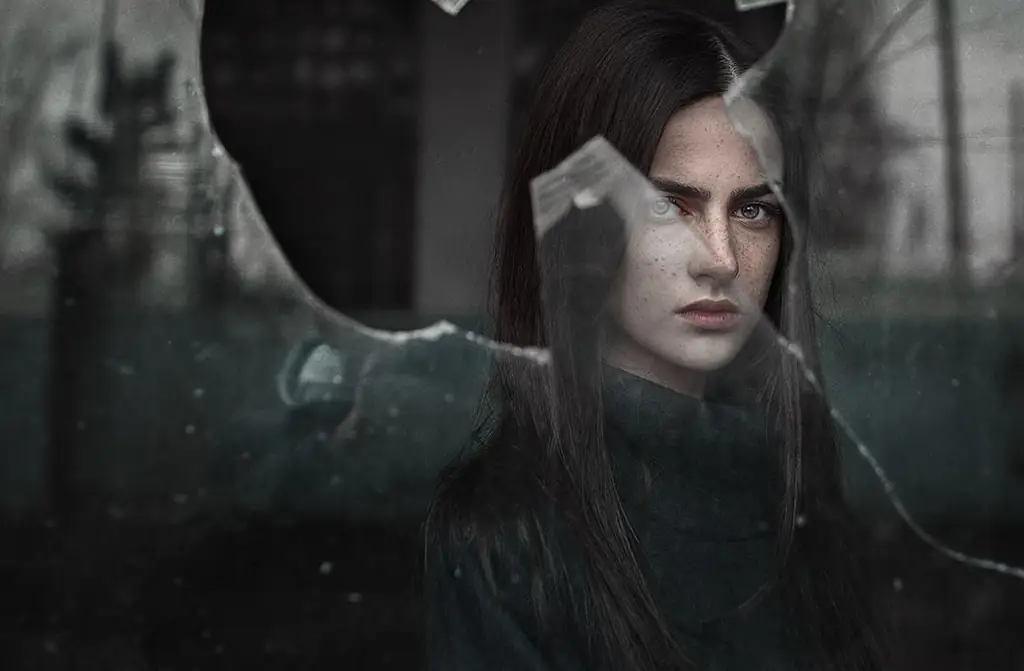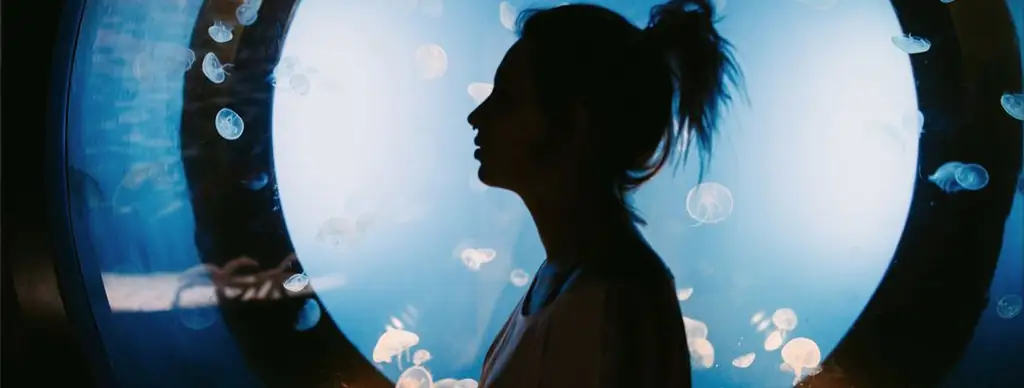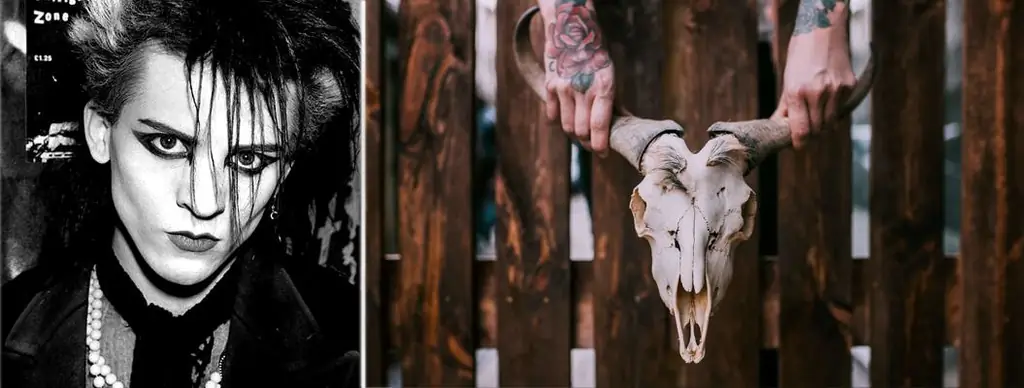- Author Adrian Jeff [email protected].
- Public 2023-12-17 05:06.
- Last modified 2025-01-24 14:09.

Pseudo-romance of death, or the Subculture is ready
Beautiful and smart, artistic, talented and informal. What attracts adolescents to the Goth subculture? Are they just sensual kids who want to stand out from the crowd? Or do they have psychological problems that need to be addressed? Who are they really and how to understand them from the inside? …
In the late 70s in Great Britain, on the basis of the youth punk movement, the gothic subculture took its origin. It has gained mass character and popularity among fans of gothic music performers, the main idea of which is the chanting of death.
This subculture was divided into several heterogeneous separate directions, fashion trends were set by the musicians themselves, on whose appearance their fans were guided. Basically, it is black in clothes and black hair, pale face and gloomy makeup, metal and silver accessories, crosses and the Egyptian ankh as a symbol of eternal life, images of bats and symbols of death. Additionally, piercings and tattoos on open areas of the body and face, red lenses, false fangs or chains in the nose may be present. So the Goths stood out among the representatives of other subcultures, for example, punks or hippies.
The subculture developed mainly in England and Europe, but also became popular in North America and, to a lesser extent, in Asia and Australia. The Gothic subculture came to Russia a little later, in a distorted form. Representatives of this subculture in Russia are relatively few in number, since gothic rock in Russia is less popular than other genres. There are local Gothic communities in large cities, but Goths in Russia face hostility or inadequate reactions to their looks or hobbies. They are called "informals" because they stand out from the crowd. However, this does not prevent them from continuing to do what attracts them.
The attitude of society towards the Goths is different. Some are afraid of them and bypass them, others feel sorry for them from the heart, others hate them. Parents cannot understand what is happening with their children who are fascinated by this subculture. At 15-16 years old, or even earlier, they change not only externally, but also internally. Parents are afraid of losing touch with a child who already considers himself an adult and independent.
Beautiful and smart, artistic, talented and informal. What attracts adolescents to the Goth subculture? Are they just sensual kids who want to stand out from the crowd? Or do they have psychological problems that need to be addressed? Who are they really and how to understand them from the inside?
What is hidden behind the appearance of a goth, how to understand his personality and desires, we will analyze in this article.
Why teenagers choose subcultures for themselves
Teens at different ages may have a desire to join a subculture. They make such a decision when they have already formed their views on life. They try to realize their natural properties on their own, try to find realization, look for ways to fulfill and enjoy.
Of course, not everyone will go to such a community. This is due to the properties of our psyche. System-vector psychology of Yuri Burlan says that each person has innate mental properties, which are divided into eight vectors, each of which is unique. A modern person, as a rule, has from three to five vectors.
A vector is the properties of a person's character, a set of desires and abilities, a way of thinking, given to us from birth. Each of the vectors needs development and filling, and a person subconsciously seeks to fill the desires of all his vectors.
Among us there are special people with high emotionality, openness, who perceive the world through their eyes. They are also characterized by empathy, amorousness, demonstrativeness and great potential for visual intelligence. We are talking about the owners of the visual vector, which is based on emotional experiences ranging from fear of death to universal love.
By bringing emotions of empathy and love into our lives, they create culture and art, limiting general hostility in society. The described properties are given by nature in the visual person from birth, but they need development and education.
Different states of the visual vector
We are all born in an undeveloped state and develop into our opposite. In the visual vector, these are two states: fear and love. A child with a visual vector is born with a fear of death, which primarily manifests itself in the fear of the dark or the fear of being alone. Fear is the primary and most powerful emotion. While developing, a person gets rid of fear, bringing it out into empathy and love, when he becomes afraid not for himself, but for another. A developed and realized visual vector is compassion, empathy and empathy for another person.
It is in the case of insufficient development and implementation of the visual vector that a teenager is drawn to various subcultural communities. Tendentiously, the bulk of adolescents who have come to the Gothic subculture have a visual vector in a state of fear. They are united not only by common interests, but also by the general properties of the psyche.

Unlearned to bring emotions out, into compassion and love, visual adolescents are looking for their own kind and replenish subcultural groups. In this state, they like to attract attention to themselves with clothing or outwardly shocking, to stand out from the crowd.
The essence of demonstrativeness is ready - this is a subconscious desire to frighten others and to be afraid of oneself, experiencing the filling of the visual vector with the emotion of fear. Outwardly, this is expressed by going to the cemetery in the dark, make-up under the "corpse", black hair and black clothes. Addiction to the symbolism of death indicates the visual vector in a stressful state.
The internal state of such adolescents is a buildup of emotions from the state of "very scary" to "not very scary." In a stressful or undeveloped state, the viewer requires love for himself and is not able to give love. He cannot realize the full potential of his properties to the fullest and experience love, compassion and empathy for other people.
You need to understand that in both a developed and a stressful state of the visual vector, a person will strive to obtain satisfaction, that is, to experience vivid emotions. Only this will be achieved in different ways: either by feeling empathy with other people and building emotional connections, or by emotional swings and filling with fears.
Philosophy is ready
Being a goth implies a difficult state of mind, a special worldview. These are completely separate, independent culture and philosophy. You can't dress in black, dye your hair black and call yourself a goth. First of all, a goth is a fan of gothic music, adhering to certain philosophical views.
The lyrics of gothic music are imbued with the meaning that there is nothing good in earthly life, that all the best awaits a person in life after death, and death itself is a deliverance from suffering. In addition, life is not eternal, or the matter is death.
Often they even confuse Goths with punks or emo, although these are completely different and independent subcultures. There is a certain stereotype in society that the Goths are something like a sect, they gather in cemeteries, look like Satanists, resort to esotericism and mysticism.
Among the representatives of the ready there are many intellectually developed and well-read people who are simply attracted by gothic music or an interest in mysticism. Teens with a subtle and romantic soul, a good education and a creative nature, inclined to poetry or drawing, can also be Goths. This manifests itself in their work, whether it be drawings, poetry or music in the style of dark romance, mysticism and mystery. All these are just manifestations of the properties of the psyche.
Depressive states of goth-sounders: differences between sound and vision
You can often find statements that goths tend to think about death and suicide because of the subtext of music. However, this must be distinguished from the actor's imitation of the spectator. It is impossible to artificially force yourself to be depressed. Real depression is a state of the sound vector. Simulated depression can always be distinguished by understanding the sound vector and distinguishing it from the visual one.
It can be noted that the musicians and performers of gothic music themselves, as well as outstanding figures of this subculture, are carriers of the sound vector or the sound-visual bundle of vectors. As Yuri Burlan's System-Vector Psychology says, the volume of the psyche of the sound vector is much larger than that of the visual one, and the desires of the sound vector differ from the desires of all other vectors.
The sound vector means that a person has abstract intelligence, the potential talent of a writer and composer, musician and poet. It's hard for a sound person to find joy in material things. Neither material goods, nor a moped at the age of 16 can fill this volume. All a sound engineer needs is to find the meaning of life. Finding peace in darkness, silence and loneliness, in maximum concentration, he realizes that noise and fuss are not for him, life seems to him filled with suffering. And, not finding his realization in life, he may come to the conclusion that only death will bring peace and harmony to his soul. Alone with himself, such a sound engineer tries to bring his states out - into his texts and music.
Ready with a sound vector less than a visual one. The sound vector is observed tendentiously among the group leaders. Viewers are not characterized by constant depressive states, they prefer to spend time at parties and in other places where they can demonstrate themselves. However, in a state of fear, the spectators are attracted to the sound people in the corresponding state.
Walking through the cemetery also carries different meanings for different vectors. If for the spectator such meetings fill their fears, then for the sound engineer it is an opportunity to be in contemplation of life and death, meaning. Unlike spectators, sound people will always prefer peace and quiet, sometimes - small quiet companies of their closest friends. They tend to be withdrawn, are introverts. They see and perceive this world differently. These are the so-called Mopey Goths, which are considered to be real Goths, because they exactly correspond to the very essence of the subculture.
People with sound-visual vectors may tend to listen to heavy music, have conversations on a suicidal topic, they have a non-standard attitude to life and the world. In addition to the mood swings that are characteristic of the spectators, they, like sound specialists, may have depression, withdrawal, states such as detachment, lack of facial expressions can be seen on their face. You can also hear statements about the meaninglessness of life from them.

Sound-visual musicians glorify death in their work, since their visual vector is filled with the fear of death, and the sound vector fills the music with meaning, that is, arguments about the meaning of life, which in this case look mystically colored. All this attracts fans to them in the same conditions. The general properties and states of vectors are what unites people into a separate subculture, giving this a special aesthetics, style and forms of behavior.
Risk zone: the danger of suicidal ideation and the victim scenario in adolescents
Suicidal thoughts and completed suicide always indicate the presence of a sound vector. Such thoughts do not come in one day, in an instant. It is always a long way to find answers to questions about the meaning of life. The sound engineer has such a different outlook on life that people without a sound vector can find it difficult to understand it.
In his isolation and loneliness, the sound engineer tries to comprehend his life in this world. At the same time, he feels his difference from others, it is difficult for him to fit into the flow of life. Only the sound engineer is able to sense his mortal body apart from the immortal soul and falsely assume that getting rid of the body will bring him happiness. It should be understood that not every sound engineer has suicidal thoughts and is prone to suicide. However, every suicide has a sound vector.
Fearful spectators can also become victims. The range of a person with a visual vector is from a victim in an undeveloped state to a sacrifice in a developed state. In the System-Vector Psychology of Yuri Burlan there is such a concept as a victim complex. It is caused by the presence of a skin vector with masochistic tendencies in a person in combination with an undeveloped visual vector. At a short distance, manifestations of victimization are also possible in a developed visual person, for example, in the case of overstress. Emotional swings of the visual vector during walks around the cemetery at night fill a person with strong and vivid emotions of fear, which on a subconscious level can attract a criminal.
However, not every goth is at risk. By themselves, the Goths do not pose a danger to society, although their appearance can cause hostility from others. The reason for the suicide and victim scenario lies not in subcultures as such, but in the poor states of sound and visual vectors.
System-vector psychology of Yuri Burlan explains that in potential such people can become poets, writers, composers, musicians, programmers with a developed and realized sound vector. Or doctors, artists, actors, singers, if the visual vector is developed and implemented. This is given by nature, but requires development and implementation.
Informal youth: is it okay to be different from everyone
If a teenager has chosen such content for himself as the subculture is ready, then he should not actively interfere. House arrest at 16 and being banned is the worst option for building a relationship with a teenager. The teenager seeks for himself that pleasure that can fill his desires.
Goths are people too, even if they do not look like it is usually accepted in society. They are normal in their own way, they just have their own outlook on life. They have the same vectors as other sound and visual people, they just want to realize themselves in a different way. In our time, it is dangerous not to be a goth, but not to understand the properties of your psyche and your potential.
Today the gap between generations is so great that children differ from their parents not only in the set of vectors, but also in the volume of their psyche. In adolescence, parents forget that their child's priority is not the opinion of the parents, but the views of friends.
A teenager can get distracted from interests in the subculture if you offer him something more interesting and exciting, more filling his needs in sound and visual vectors.
You can learn more about this at the free online lectures on system-vector psychology by Yuri Burlan. To participate, register:






